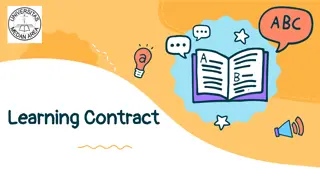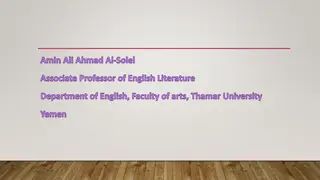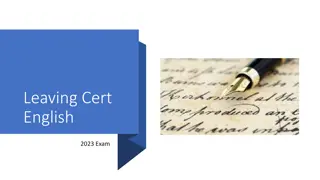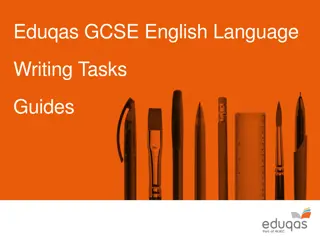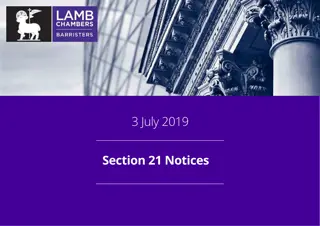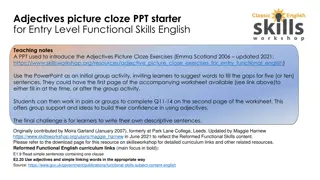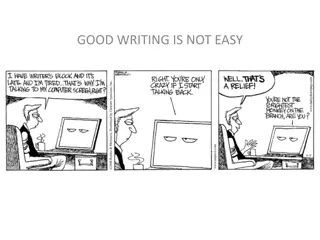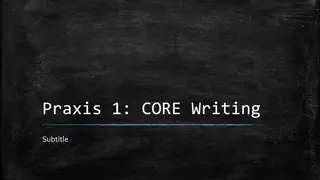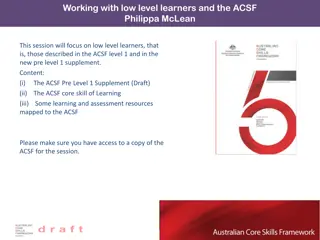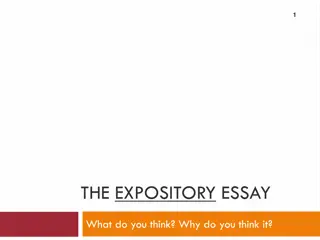Mastering Functional Skills English Level 2: Writing Section Guide
Functional Skills English Level 2 focuses on reading and writing exams, along with a speaking and listening component. This course enhances your comprehension and writing abilities, teaching you to extract meaning from texts and craft your own writings using various techniques. The writing section involves using language and presentation features effectively. By understanding different types of writing and employing efficient planning techniques like spider diagrams, you can excel in producing well-structured texts for the exam.
Download Presentation

Please find below an Image/Link to download the presentation.
The content on the website is provided AS IS for your information and personal use only. It may not be sold, licensed, or shared on other websites without obtaining consent from the author. Download presentation by click this link. If you encounter any issues during the download, it is possible that the publisher has removed the file from their server.
E N D
Presentation Transcript
Functional Skills English Level 2
Course Breakdown Functional Skills English is broken up into several components. They are as follows: Reading Exam Level 1 = 60 Minutes, Level 2 = 75 Minutes Writing Exam Level 1 = 60 Minutes, Level 2 = 60 Minutes Speaking & Listening Component = 20 Minute Discussion & 10 Minute Presentation This booklet will guide you through the Writing section of the course. Course Content: This course will booster your ability to draw meaning from texts to answer questions, as well as constructing your own pieces of writing using similar techniques. You actually use all of these skills already, you just may not know the technical language for these skills!
FS Writing So far, you ve covered techniques and tips for dealing with the reading exam, but now we re going to focus on writing! You ve done a lot of the ground work already! Reading is you using Language and Presentation features to draw meaning from a text, writing is you producing a text using the same techniques! You already know how to spot them, but now we need to practice using Language Features and Presentation Features in our construction of texts (you most likely already do this, you just don t know that s what you re doing!)
Types of Writing In the level 2 Functional Skills English exam you will be asked to produce two texts from the following list*. *Information comes from Pearson Edexcel Guide to Level 1 and 2 Functional Skills Writing
Writing - Planning Planning is your key to success! If you think about something ahead of time, it s always going to go smoother than just winging it. Below is the technique we advise using: Spider Diagrams Starting with a central idea, and any linked ideas coming off. This helps to give you points to expand on! REMEMBER One thing to remember with your writing questions! You will be given bullet points to guide you if you can make a paragraph from each bullet point, then you are well on course to pass the exam! Lets look at an example on the next page!
Writing - Planning REMEMBER This task is asking you to write a letter. The information you need (i.e. person you are writing to, address) is given to you, as well as two prompts; Say whether you agree with the plan. Explain your views in detail. You should use these prompts to make paragraphs for your writing!
Writing - Planning Your writing should be broken down into three main areas: Introductory statement Main body of text Summary/sign off Introductory Statement No matter the type of writing, you start with an introduction that guides your reader into what type of text they will be reading. Main Body of Text The main body of text is your main bulk of writing. It will include paragraphs made from the prompts from the question (last page). This is where you will address and answer the task given to you. Summary/Sign off The end of your writing should include a short summary of your main points, as well as
Writing Tips TAP When you see a writing task, read it carefully and think about TAP: Type Type of text you have to write e.g. letter, email, article, leaflet Audience Who will read your writing? Who are you writing to/for? Purpose Why are you writing? What are you writing about? What do you want? Example task: Below is an example task; Using TAP, we can quickly identify what we are being asked to do! TYPE- what you have to write? Audience- who you are writing for Write a letter to the chairperson of your local council, persuading them to create better leisure facilities for residents of your age Purpose- why you are writing
Writing Tips PEE paragraph What is a PEE paragraph? It s not as dirty as you think!! PEE is a technique we can use to help structure our paragraphs. It stands for: Point- tell the reader your main point Evidence- give facts/anecdotes to prove your point is sensible Explain- explain your main point in more depth, add details to it Try it out! Below is an example question you could be asked for the writing paper. You have also been given a bullet point to guide you. Try to write a PEE paragraph in response to this bullet point. Could You Live without your favourite gadgets for a fortnight? Which gadgets would you find most difficult to give up and why? (There is space on the next page to write your response!)
Practice Exam Time: 1 Hour In the real exam, you will have one hour to produce your two texts. The following two tasks are examples of what you may be asked to write in the exam. We will be having a go in exam conditions; the practice we work through later will be work shop style, where we can help each other. After, there will be a short break, and then we will look at example answers from the exam board, as well as the mark scheme!
Things to remember in the exam: Read all the information you are given for the first question. Use the form given, as well as the bullet pointed information, to plan your writing. After completing the first question, repeat this for the second question. You have 60 minutes to answer the questions inside. Remember to use your language features to effectively connect with the reader. Be careful to check your tenses, spelling and paragraphing. Good Luck!

 undefined
undefined














